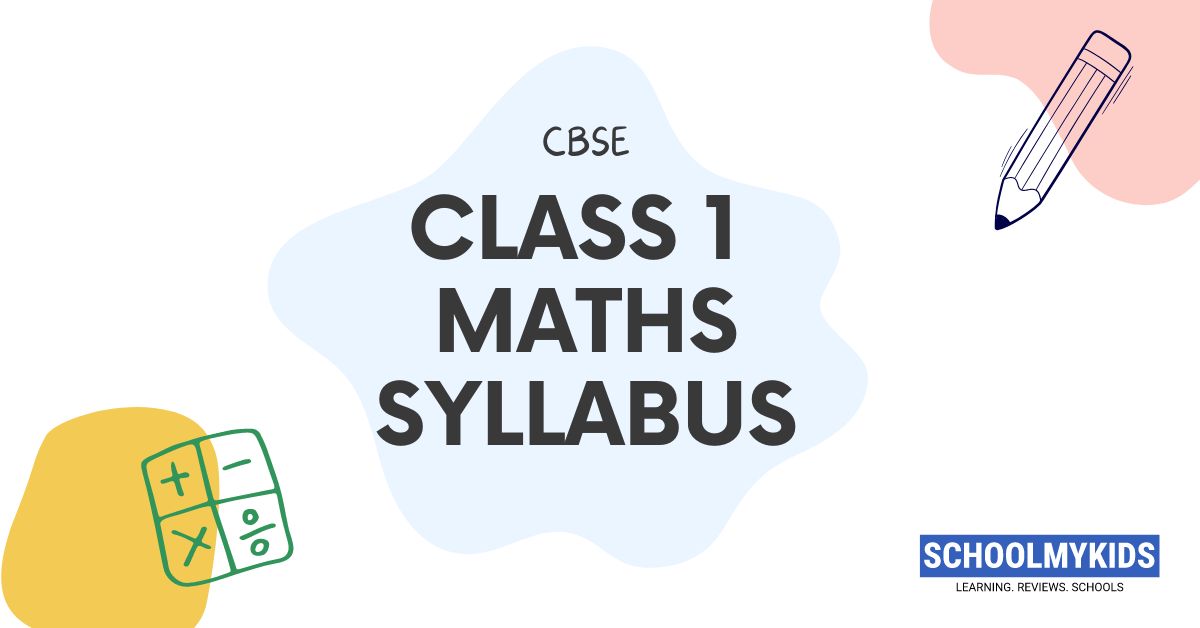Mathematics is an essential subject for a child’s development and the CBSE Class 1 Math Syllabus is designed to provide a strong foundation for further studies. The curriculum for CBSE Class 1 Math Syllabus focuses on building basic mathematical concepts through a variety of activities and exercises. This article will provide an in-depth look at the NCERT CBSE Math Syllabus for Class 1, including the topics covered and the objectives of each chapter.
Understanding the CBSE Class 1 Maths Syllabus
The CBSE Class 1 Math Syllabus covers the following topics:
- Numbers
- Geometry
- Measurement
- Patterns
- Data Handling
CBSE Class 1 Math Syllabus – Numbers
The CBSE Class 1 Math Syllabus for Numbers includes the following topics:
Developing a Sense of Numbers, Counting and Operations of Numbers 1-9 and 0
- Observe the object and make collections of objects.
- Arrange the collection of objects in order by
- Matching and
- One to one correspondence.
- Count the number of objects in a collection.
- Make a collection of objects corresponding to a specific number.
- Recognise and tell numbers from 1 to 9.
- Use numbers from 1 to 9 in counting and comparison. (Real objects and repeated events like clapping to be used for counting).
- Read and write numerals from 1 to 9.
- Add and subtract using real objects and pictures.
- Add and subtract the numbers using symbols ‘+’ and ‘-’. Approaching 0 through the subtraction pattern (such as 3 – 1 = 2, 3 – 2 = 1, 3 – 3 = 0).
Numbers from (10 – 20)
- Form number sequence from 10 to 20.
- Count objects using these numbers.
- Group objects into a group of tens and single objects.
- Develop the vocabulary of a group of ‘tens’ and ‘ones’. Show the group of tens and ones by drawing.
- Count the number of tens and ones in a given number.
- Write the numerals for eleven to nineteen.
- Write numerals for ten and twenty.
- Compare numbers up to 20.
Addition And Subtraction (Up to 20)
- Add and subtract numbers up to 20.
Numbers from 21– 99
- Write numerals for twenty-one to ninety-nine.
- Group objects into tens and ones.
- Draw representation for groups of tens and ones.
- Group a number orally into tens and ones.
Mental Arithmetic
- Add two single-digit numbers mentally.
Syllabus for CBSE Class 1 Maths: Money
The syllabus for Money is given below:
- Identify common currency notes and coins.
- Put together small amounts of money.
Syllabus for CBSE Class 1 Maths: Measurement
The syllabus for Measurement is given below:
Length
- Distinguish between near, far, thin, thick, longer/taller, shorter, high, low.
- Seriate objects by comparing their length.
- Measure short lengths in terms of non-uniform units (in the context of games e.g. ‘Gilli Danda’ and ‘marble games’).
- Estimate distance and length, and verify using nonuniform units (e.g. hand span etc.)
Weight
- Compare heavy and light objects.
Time
- Distinguish between events occurring in time using terms – earlier and later.
- Get the qualitative feel of long & short duration, of school days v/s holidays.
- Narrate the sequence of events in a day.
Syllabus for CBSE Class 1 Maths: Data Handling
The syllabus for Data Handling is given below:
- Collect, represent, and interpret simple data such as measuring the arm length or circumference of the head using a paper strip.
Syllabus for CBSE Class 1 Maths: Pattern
The syllabus for Pattern is given below:
- Describe sequences of simple patterns found in shapes in the surroundings and in numbers, e.g. stamping activity using fingers and thumb.
- Complete a given sequence of simple patterns found in shapes in the surroundings.
Conclusion
The CBSE Class 1 Math Syllabus is a comprehensive and well-rounded curriculum that provides students with a strong foundation in mathematics. From recognition of numbers and basic shapes to understanding patterns and data handling, the syllabus covers a range of topics that are essential for a child’s development. With its engaging and interactive approach, the CBSE Class 1 Math Syllabus helps students to develop their mathematical skills, foster a love of learning, and build a strong foundation for future studies.
Frequently Asked Questions
What is the importance of the CBSE Class 1 Math Syllabus?
The CBSE Class 1 Math Syllabus is important as it provides a strong foundation for further studies in mathematics. It helps to develop a child’s critical thinking and problem-solving skills, as well as their ability to understand and analyse data.
What are the objectives of the CBSE Class 1 Math Syllabus?
The objectives of the CBSE Class 1 Math Syllabus are to develop a child’s mathematical skills, build their understanding of basic concepts, and foster a love of learning. The syllabus covers topics such as numbers, shapes, measurement, patterns, and data handling, with the aim of providing a well-rounded education in mathematics.
How is the CBSE Class 1 Math Syllabus taught?
The CBSE Class 1 Math Syllabus is taught through a variety of activities and exercises, including hands-on learning, visual aids, and problem-solving activities. Teachers aim to make the subject engaging and interactive for students, helping to foster a love of learning and build a strong foundation for future studies.








Be the first one to comment on this story.